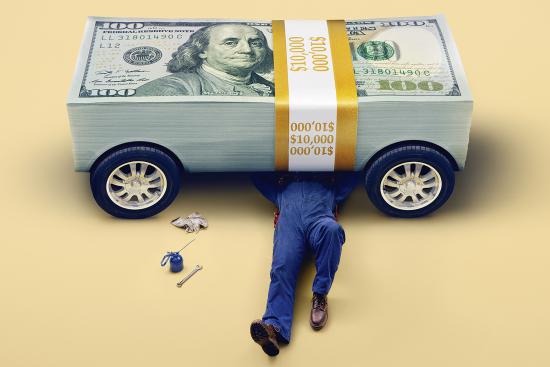After getting knocked around in the harsh winter months, your car could probably use a few minor repairs, especially before the summer driving season gets underway. The same premise holds true for your portfolio this year.
The start of 2016 was an especially rough ride for your investments, with U.S. stocks sliding more than 10% through mid-February before regaining traction and revving up 13%. Your foreign equities slipped and slid, too, with Chinese stocks careening further into a bear market even as other parts of the emerging markets began getting into gear. Meanwhile, yields on 10-year U.S. Treasuries returned to sub-2% levels while some global bond yields turned negative—meaning you’re paying a small sum to park your money in a seemingly safe place—throwing a wrench in your income strategy.
You’re probably just glad that the bumpy first half of the year is in the rearview mirror. But now’s the time to make sure you’re still on the right road by taking these simple steps:
Check your alignment
A critical step in any tune-up is to see if your car is properly balanced. For your portfolio, that means determining if market gyrations have thrown your stock-and-bond mix out of whack.
• Run a diagnostic. You may assume that not much has changed, since equities and bonds are up modestly this year. But a look under the hood may show bigger shifts have occurred over time. U.S. stocks have been rallying since early 2009, while bonds have been delivering below-average returns. If you haven’t rebalanced in a while, “you could easily be equity-heavy,” says Harold Evensky, a financial planner in Coral Gables, Fla.
For example, a 50% stock/50% bond portfolio three years ago would now be 55% equities/45% fixed income. Left untouched over the past five years, a 50-50 strategy would now be closer to 60% stocks and 40% bonds.
• Make sure your wheels are pointed in the right direction. Now is also a good time to double-check that your portfolio can still get you where you need to go—or if it needs a turbocharge of savings to get back on track. These free calculators allow you to plug in your savings strategy, and you’ll be able to tell if your current pace of contributions is sufficient to meet your retirement needs. “The good thing about doing this now is that you still have enough time to boost your savings before year-end,” says Christine Benz, director of personal finance at Morningstar.
Another bonus: If you must accelerate savings, you can fix your alignment problems at the same time. For instance, if you’re 40% in bonds now but ought to be closer to 50%, rather than sell your equities to replenish your stake, simply funnel new contributions into fixed income for the remainder of the year.
Rotate your tires the right way
Drill down beneath your basic asset-allocation strategy and you may find that several subcategories of investments have diverged, which may require rebalancing. The trick is not to go overboard.
• Rebalance only if you have to. Dialing back your exposure to certain assets because their weightings shifted a point or two doesn’t make sense. You have to give investments some room to run. Start paying attention when your allocations are off by at least five percentage points. If your weightings are off 10 points or more, it’s definitely time to act, says Evensky.
One area where this may be the case is with emerging-markets stocks, which have lost ground since 2011. If you haven’t rebalanced in recent years, you’ll probably need to replenish this portion of your foreign equity stake (see chart).
• Shift out of expensive stocks into undervalued sectors. Defensive stocks have benefited this year as investors have worried about a global economic slowdown. Through May 20, Steady Eddie utilities gained 12.5%, and consumer staples stocks were up 3.9%, while the S&P 500 returned just 1.3%. But the winners now look pricey. Utility stocks, which have historically traded in line with the broad market, sell at a 4% premium.
What to do? Shift into attractively priced sectors that also tend to do better in the latter stages of an aging bull market, such as industrials and consumer discretionary stocks. “We could be at a point in the business cycle where they start to become attractive,” says Tracie McMillion, head of global asset allocation strategy for the Wells Fargo Investment Institute. You can easily add broad sector exposure through an ETF such as Industrial Select Sector SPDR XLI 0.64% , which charges a mere 0.14% a year, and Vanguard Consumer Discretionary ETF VCR 0.87% , which charges just 0.10%.
Robert Arnott, chairman of the investment firm Research Affiliates, also suggests pulling back from big, fast-growing stocks that have dominated the market—think Facebook and Amazon—and favoring value-oriented stocks instead. After lagging the market for several years, shares of overlooked or beaten-down stocks are finally perking up. Try a low-cost fund that seeks out deeply discounted shares, such as Dodge & Cox Stock DODGX -0.83% , which is on our MONEY 50 list of recommended mutual and exchange-traded funds.
Flush out gunk in your engine
If you need to sell some winners in a taxable account to rebalance, here’s how to minimize the pain:
• Clear out some of your losers. Dump some losing investments in your taxable account now to realize capital losses. Then use those losses to offset gains elsewhere in your portfolio. If you have more losses than gains, you can deduct as much as $3,000 in ordinary income with the additional sums. Still have losses after that? You can bank them to use in future years.
Your search for losers starts in the energy sector. Oil prices have come off their lows, but the S&P 500 energy sector is still down 29% from two years ago. Also think biotech. After rallying in recent years, shares of biotech companies have plunged around 30% over the past 12 months.
Read more…
Read the full article at: time.com
Time for a #financial tune-up? Summer is the perfect time to kick the tires on your #investment #portfolio.
#familybank






